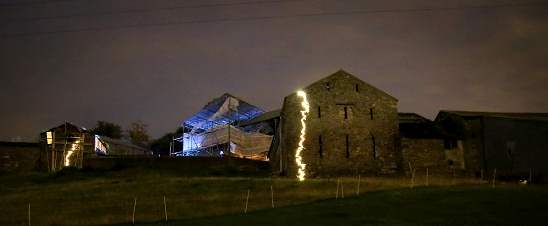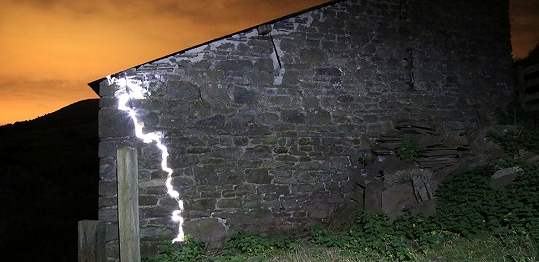Llwyn Celyn is at a turning point, on the very cusp of change, when its slow decay begins to be reversed through careful restoration and conservation work. It was timely then, that on the evening of Saturday 23rd April 2016, artists Jamie Lake, Will Carter and Fiona Hamilton presented their work in response to the site – work that captures Llwyn Celyn as it waits for this process to begin.
Jamie Lake is one of four artists in residence who will be documenting the site during the course of our work. Jamie chose to focus on the period prior to the start of the restoration and conservation work, capturing the site in its current state - a derelict medieval farmstead on the brink of serious decay:
"To me the fractures were the visceral signs of change: the often overlooked but violent marks of dissolution. Conservation and restoration can appear to work contrary to this, filling in the fissures and bringing back together what has fallen apart. I wanted to bring the fractures in to focus, to record them before they were resealed, and to reflect on the mutability of Llwyn Celyn. I wanted to have and to create a momentary pause: to sense the fragility of what seemed intense and present, before it moved on."

Jamie designed the light installations and then worked with Will Carter to photograph the illuminated fractures and fissures in the buildings, to create images that expose the fragility of the fabric and the urgency of the work. Jamie was also joined by poet Fiona Hamilton, who documented her observations and responses:
"The idea of light in the cracks and crevices of buildings is fascinating. So working in this building and this place felt very important. It’s still a home to many creatures, animals, insects, plants. Is has been a home to people over many centuries and it will be a habitation again. It made me think about myself as a visitor, coming into this space. Noticing small things left in the building were like little invitations to think about other times. And here in this valley where the hills are ancient, the houses medieval and centuries old, alongside the life cycle of humans and of insects - all those time scales co-existing and over lapping, fascinated me."

Presenting the work on Saturday evening involved re-creating many of the light installations that Jamie had experimented with during the course of the winter months. On this occasion though, he did not have to fight the winter wind and rain. The April day was still and sun soaked. Jamie and Will also set up a series of projections, casting images of thawing water, and wind whipped wall paper across the stone walls of the stable and Threshing Barn.
As our audience arrived the long spring evening was just starting to fade and turn to night fall. There was still just enough warmth in the air to enjoy the site, and the works, with hot drinks in hand, before gathering in the Threshing Barn to hear Fiona read a selection of her poetry. Fiona’s keen observations were retold against the backdrop of the sheep bleating in the fields, dogs howling in the neighbouring farms and the descending sounds of bird song. We also heard her opening and closing poems performed in Welsh by Cari Barley.
Llwyn Celyn will inevitably change. But on this evening we were able to appreciate how the buildings wear their time, as a measure their geological foundations and their history. The lights illuminating the fractures exposed their fragility, but also celebrated human activity and beckoned us to think about what the future may hold here.
Llwyn Celyn by Fiona Hamilton
Let there be light
in the cracks and crevices of old walls
in the spaces between bricks
Where mortar has crumbled and spilt.
Let light shine where wooden beams list,
incapable, now, of holding back
the farm’s slow-motion yawn
through stretched, weathered, skin.
Let light illuminate absences,
gaps where beetles have burrowed
and walls have sunk
in softened, rain-logged land.
Let light be deliberate and bold:
photon-rivers flowing
through a barn’s breach,
a flaming brand lancing a dark field.
Let this moment be lit
So we see
not what we came here for
but the inverse:
the overlooked, the undervalued
residues and remnants,
a scintilla of particles
rejoining earth, wind, rain.
Llwyn Celyn was translated into Welsh by Simon Cavendish and Elin ap Hywel. It was performed in Welsh by Cari Barley. You can listen to it here.
For more images, poems and information please visit the artists’ websites:
www.fionahamilton.org
www.williamhcarter.com